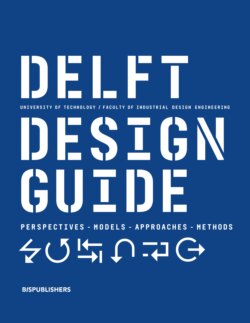Читать книгу Delft Design Guide -Revised edition - Annemiek van Boeijen - Страница 44
На сайте Литреса книга снята с продажи.
ОглавлениеHow? You can use the model in several ways, such as structuring your thoughts, communicating with others during the design process, generating questions, and structuring insights from research. The model is described as follows:
----------------
Form: The geometrical and material form of a product is specified in its design. The parts that make up a design are realised in the production process.
----------------
Properties: Due to its form, a product has certain properties, such as weight and stiffness. Properties describe the expected behaviour of a product under certain circumstances, and they can be intensive or extensive. Intensive properties are completely determined by the material of a part, such as its weight. This kind of properties and the geometrical form determine the extensive properties. For example, both the material used and the geometrical
form determine the strength of a component. As a designer, you would typically focus on the extensive properties, as they are the most direct component in determining the functioning of a product. We need to remember that these properties have both desirable and less desirable consequences. For example, steel is stiff and durable, but it is heavy and also rusts, while aluminium is light and does not corrode, but it is less stiff. The art of designing is to give the product a geometrical form such that the product still has the desired extensive properties along with its intensive ones.
----------------
Function: Properties and functions both describe the behaviour of things. Statements on properties are objectively true or false. For functions, this is not necessarily so: Functions express what a design is made for, and
while these depend on the intentions of the designer, they also depend on the preferences, objectives, and goals of users. The designer of a ballpoint pen may have kept specific functions in mind, such as the need to transfer the ink to the paper or that the pen should display the brand name. Users may have considered the alternative functions of a pen, such as its ability to keep a hairdo in place. As we can see, functions can have a variety of traits – they can be technical, ergonomic, aesthetic, semantic, economic, societal, and more.
----------------
Needs and Values: Through their functions, products can satisfy the needs of users and realise values. For example, a ballpoint pen can help individuals satisfy their need of expressing themselves in writing and thereby support aesthetic, cultural, or economic values.
Reasoning in Design
What & Why? Products and services are designed to serve specific usage functions; they are made in a way where they can fulfil specific needs and support certain values. To design a product is to conceive its use and to find a suitable geometrical and physio-chemical (or material) form that fulfils the intended function and the desired needs and underlying values. The kernel of designing lies in the reasoning process that occurs when we examine these values via needs, functions, and properties, and then bring them to a final form.
The functioning of a product depends on its form, use, and context of use. This means that if you know the geometrical and physio-chemical form of a product, you can in principle predict its properties. Along this line, if you also know the environment where the product will be used in and how it will be used, you can predict whether the product will work as intended. This kind of reasoning is called an analysis . However, for designers the essential mode of reasoning is to reason from function to form – this is referred to as synthesis , which is a process that starts with the values and needs of the potential user, and ends with the form of a product that can satisfy those values and needs.
--------------------------------------------------------------------------------------------------------------------
Mindset: This model suggests an analytical and structured way of thinking. A mindset that some designers may not be aware of in practice. Therefore, articulating the different levels in an explicit way leads to more informative discussions during the design process.
Tips & Concerns
Both the form and also the mode and conditions of use determine how a product will function in action. The context of use counts as much as the product itself, and therefore you will need to pay equal attention to both these areas. In a sense, designing a product should include designing its use.
-----------------------------
Limitations
Intuition and creativity have an indispensable role to play in design. Notwithstanding the importance of scientif- ic knowledge, systematic approaches, and modern possibilities for simulation, we can say that design processes would come to a standstill without intuition and creativity.
The Reasoning in Design model is a generic representation of how designers process their ideas in a logical manner when designing.
The model is primarily based on the design of tangible products, but
it can be applied to services as well. The model helps to reflect on
the different levels of reasoning while designing.
MODELS
---------------------------------------------------------------------------------------------------------------------------------------------------------------
---------------------------------------------------------------------------------------------------------------------------------------------------------------
References & Further Reading: Roozenburg, N.F.M. & Eekels, J., 1995. Product Design: Fundamentals and Methods. Chichester: John Wiley & Sons. / Roozenburg, N.F.M. & Eekels, J., 1998. Productontwerpen: Structuur en Methoden . 2 nd ed. Utrecht: Lemma.
43
